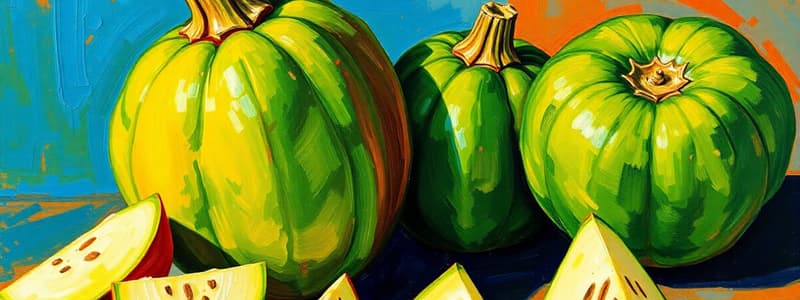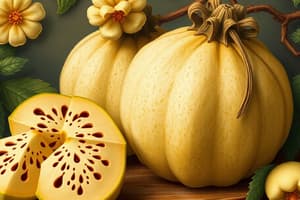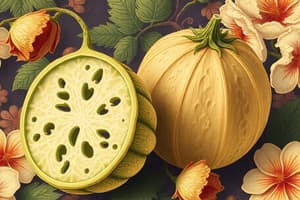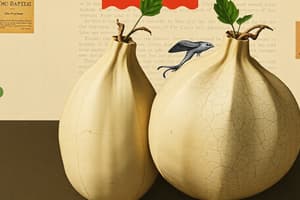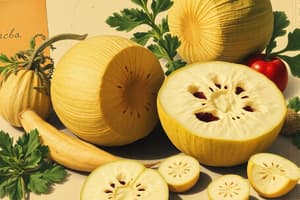Podcast
Questions and Answers
Which characteristics identify jicama as a perennial plant?
Which characteristics identify jicama as a perennial plant?
- It lives longer than two years and often goes dormant in winter. (correct)
- It produces seeds every year.
- It grows taller than most other plants.
- It requires frequent replanting each season.
What is the primary part of the jicama plant that is utilized for food?
What is the primary part of the jicama plant that is utilized for food?
- Leaves
- Stem
- Tuberous root (correct)
- Flowers
In which two regions of the world is jicama most widely grown and used?
In which two regions of the world is jicama most widely grown and used?
- Southeast Asia and Central America (correct)
- Middle East and African savanna
- North America and Europe
- Australia and Antarctica
Which method is NOT involved in processing jicama for consumption?
Which method is NOT involved in processing jicama for consumption?
What type of plant is jicama classified as?
What type of plant is jicama classified as?
What part of the Jatropha plant is primarily harvested for economic purposes?
What part of the Jatropha plant is primarily harvested for economic purposes?
What is the first step in the processing of Jatropha seeds after harvesting?
What is the first step in the processing of Jatropha seeds after harvesting?
Which method can be used to extract oil from crushed Jatropha seeds?
Which method can be used to extract oil from crushed Jatropha seeds?
In what economic sector is Jatropha primarily utilized?
In what economic sector is Jatropha primarily utilized?
What is the final step in the processing of Jatropha seed oil to enhance its quality?
What is the final step in the processing of Jatropha seed oil to enhance its quality?
What defines a true root in the context of vegetable crops?
What defines a true root in the context of vegetable crops?
Which of the following vegetables is classified as a bulb?
Which of the following vegetables is classified as a bulb?
Which factor contributes to the pungent flavor of food bulbs in the Allium genus?
Which factor contributes to the pungent flavor of food bulbs in the Allium genus?
Which of the following examples is NOT considered an above-ground vegetable crop?
Which of the following examples is NOT considered an above-ground vegetable crop?
What distinguishes corms from bulbs in plant classification?
What distinguishes corms from bulbs in plant classification?
What was a major consequence of the potato blight that occurred in Ireland in the mid-1800s?
What was a major consequence of the potato blight that occurred in Ireland in the mid-1800s?
Which of the following statements accurately describes the potato?
Which of the following statements accurately describes the potato?
Which yam species is known for producing tubers weighing up to 20 kg?
Which yam species is known for producing tubers weighing up to 20 kg?
What characteristic of taro makes it necessary to be cooked before consumption?
What characteristic of taro makes it necessary to be cooked before consumption?
What was one of the main reasons for the unreliability and high cost of spice supply to Europe before 1499?
What was one of the main reasons for the unreliability and high cost of spice supply to Europe before 1499?
What was one of the initial uses of spices in food?
What was one of the initial uses of spices in food?
Which European company initially monopolized the spice trade after Vasco de Gama's discovery?
Which European company initially monopolized the spice trade after Vasco de Gama's discovery?
Which historical event significantly contributed to the spread of spices to northern Europe?
Which historical event significantly contributed to the spread of spices to northern Europe?
What is a notable characteristic of the Mint Family of spices?
What is a notable characteristic of the Mint Family of spices?
Which herb from the Mint Family is primarily used in Italian cooking?
Which herb from the Mint Family is primarily used in Italian cooking?
What was a primary product imported through the Spice Trade from other regions?
What was a primary product imported through the Spice Trade from other regions?
What effect does drying mint leaves have on their essential oils?
What effect does drying mint leaves have on their essential oils?
What was one consequence of Marco Polo's expeditions during the Spice Trade?
What was one consequence of Marco Polo's expeditions during the Spice Trade?
What is the primary measure of efficiency in bioethanol production?
What is the primary measure of efficiency in bioethanol production?
What historical impact did the cultivation of sugar cane have in the Caribbean?
What historical impact did the cultivation of sugar cane have in the Caribbean?
What type of bond links glucose units in starch?
What type of bond links glucose units in starch?
What is a significant challenge in using non-tropical species like switchgrass for bioethanol production?
What is a significant challenge in using non-tropical species like switchgrass for bioethanol production?
Why is cellulose often referred to as dietary fiber?
Why is cellulose often referred to as dietary fiber?
Which statement best describes the source of bioethanol?
Which statement best describes the source of bioethanol?
What is a key characteristic that distinguishes cellulose from starch?
What is a key characteristic that distinguishes cellulose from starch?
Which is NOT a component of gasoline?
Which is NOT a component of gasoline?
What distinguishes saturated fats from unsaturated fats in plant oils?
What distinguishes saturated fats from unsaturated fats in plant oils?
What effect does hydrogenation have on unsaturated fatty acids?
What effect does hydrogenation have on unsaturated fatty acids?
Which type of oil is characterized by having one double bond in its fatty acid chain?
Which type of oil is characterized by having one double bond in its fatty acid chain?
What is a potential health risk associated with consuming trans fatty acids?
What is a potential health risk associated with consuming trans fatty acids?
Which configuration of hydrogen atoms is associated with trans double bonds?
Which configuration of hydrogen atoms is associated with trans double bonds?
What defines extra virgin olive oil?
What defines extra virgin olive oil?
Which of the following nutrients are the seeds of sesame high in?
Which of the following nutrients are the seeds of sesame high in?
Where is the peanut originally domesticated?
Where is the peanut originally domesticated?
What is a common use for cheaper olive oil?
What is a common use for cheaper olive oil?
What role does the flower stalk play in the growth of peanuts?
What role does the flower stalk play in the growth of peanuts?
What causes the production of biodiesel to be classified as a renewable energy source?
What causes the production of biodiesel to be classified as a renewable energy source?
How does the production efficiency of canola oil compare with palm oil?
How does the production efficiency of canola oil compare with palm oil?
Which of the following plant oils results in a soap that is hard and long-lasting?
Which of the following plant oils results in a soap that is hard and long-lasting?
What is a significant drawback of biodiesel when produced from canola oils?
What is a significant drawback of biodiesel when produced from canola oils?
Which component is primarily responsible for the elastic properties of raw rubber?
Which component is primarily responsible for the elastic properties of raw rubber?
What is the primary process that stabilizes rubber against temperature changes?
What is the primary process that stabilizes rubber against temperature changes?
What effect does vulcanization have on natural rubber?
What effect does vulcanization have on natural rubber?
Which part of the Para rubber tree is primarily responsible for latex production?
Which part of the Para rubber tree is primarily responsible for latex production?
What is the consequence of a fungal leaf blight on the Para rubber tree?
What is the consequence of a fungal leaf blight on the Para rubber tree?
What is a significant advantage of using natural rubber in the manufacturing of modern radial tires?
What is a significant advantage of using natural rubber in the manufacturing of modern radial tires?
What percentage of the global rubber production is sourced from natural rubber?
What percentage of the global rubber production is sourced from natural rubber?
Which country is NOT one of the leading producers of natural rubber globally?
Which country is NOT one of the leading producers of natural rubber globally?
What major innovation did the Mayans contribute to rubber usage?
What major innovation did the Mayans contribute to rubber usage?
During which period did Manaus experience a rubber boom that significantly raised its wealth?
During which period did Manaus experience a rubber boom that significantly raised its wealth?
What process is used to increase the luster and durability of cotton yarn?
What process is used to increase the luster and durability of cotton yarn?
What is the primary composition of mature cotton fibres?
What is the primary composition of mature cotton fibres?
Which step follows the cleaning of cotton fibres after they are harvested?
Which step follows the cleaning of cotton fibres after they are harvested?
What is a significant characteristic of the kapok tree's fibres?
What is a significant characteristic of the kapok tree's fibres?
What is the primary purpose of ginning in the extraction of plant fibres?
What is the primary purpose of ginning in the extraction of plant fibres?
Which method involves decomposing plant material to extract bast fibres?
Which method involves decomposing plant material to extract bast fibres?
What type of fibres does the process of decortication primarily extract?
What type of fibres does the process of decortication primarily extract?
Which characteristic of cotton makes it one of the most valuable non-food plant commodities?
Which characteristic of cotton makes it one of the most valuable non-food plant commodities?
Which is NOT a method used for the extraction of plant fibres?
Which is NOT a method used for the extraction of plant fibres?
What is the primary step in processing coffee beans before fermentation?
What is the primary step in processing coffee beans before fermentation?
Which region was the first to record the use of coffee as a beverage?
Which region was the first to record the use of coffee as a beverage?
What type of tea is primarily produced in India and Sri Lanka?
What type of tea is primarily produced in India and Sri Lanka?
Which process follows the hand-picking of young leaves for black tea production?
Which process follows the hand-picking of young leaves for black tea production?
Which of the following countries is NOT a significant producer of tea?
Which of the following countries is NOT a significant producer of tea?
What is the primary factor that influences the final flavor of coffee?
What is the primary factor that influences the final flavor of coffee?
Which coffee species is known for its superior flavor and is commonly used in higher-quality fresh brewed coffees?
Which coffee species is known for its superior flavor and is commonly used in higher-quality fresh brewed coffees?
What is a significant characteristic of robusta coffee compared to arabica?
What is a significant characteristic of robusta coffee compared to arabica?
Which of the following regions is NOT a primary production area for coffea arabica?
Which of the following regions is NOT a primary production area for coffea arabica?
Which plant is used for extracting the stimulant alkaloid theobromine?
Which plant is used for extracting the stimulant alkaloid theobromine?
What is the primary purpose of fermentation in the production of alcoholic beverages?
What is the primary purpose of fermentation in the production of alcoholic beverages?
Which of the following grape species is primarily used in winemaking?
Which of the following grape species is primarily used in winemaking?
What is the main reason for grafting European grape varieties onto North American rootstock?
What is the main reason for grafting European grape varieties onto North American rootstock?
How are red wines produced differently from white wines?
How are red wines produced differently from white wines?
What is the role of Saccharomyces ellipsoides in winemaking?
What is the role of Saccharomyces ellipsoides in winemaking?
What is the initial step in the wine-making process after fermentation?
What is the initial step in the wine-making process after fermentation?
Which classification represents the highest quality standard for exported French wines?
Which classification represents the highest quality standard for exported French wines?
Which aspect of wine-growing regions often correlates with the price of the wine?
Which aspect of wine-growing regions often correlates with the price of the wine?
What is a notable feature of the French wine classification system?
What is a notable feature of the French wine classification system?
Which of the following is NOT a category within the French wine classification system?
Which of the following is NOT a category within the French wine classification system?
What grape varieties are primarily grown in the Burgundy region?
What grape varieties are primarily grown in the Burgundy region?
Which of the following methods is NOT part of the Champagne production process?
Which of the following methods is NOT part of the Champagne production process?
Which wine classification level in Italy allows only a simple statement of region of production?
Which wine classification level in Italy allows only a simple statement of region of production?
What type of wine is associated with the Bordeaux region's southern area?
What type of wine is associated with the Bordeaux region's southern area?
What is the primary purpose of adding yeast and sugar before corking Champagne bottles?
What is the primary purpose of adding yeast and sugar before corking Champagne bottles?
Flashcards
Jícama plant family
Jícama plant family
The botanical family of Pachyrhizus erosus (jicama).
Jícama plant type
Jícama plant type
Herbaceous herb, perennial.
Jícama native distribution
Jícama native distribution
The region where jicama originated.
Jícama use part
Jícama use part
Signup and view all the flashcards
Jícama preparation steps
Jícama preparation steps
Signup and view all the flashcards
Jatropha Plant Family
Jatropha Plant Family
Signup and view all the flashcards
Jatropha Plant Type
Jatropha Plant Type
Signup and view all the flashcards
Jatropha Native Distribution
Jatropha Native Distribution
Signup and view all the flashcards
Jatropha Economic Use
Jatropha Economic Use
Signup and view all the flashcards
Jatropha Oil Extraction
Jatropha Oil Extraction
Signup and view all the flashcards
What is a root crop?
What is a root crop?
Signup and view all the flashcards
What are the primary functions of true roots?
What are the primary functions of true roots?
Signup and view all the flashcards
What are taproots?
What are taproots?
Signup and view all the flashcards
What is a bulb?
What is a bulb?
Signup and view all the flashcards
What is a rhizome?
What is a rhizome?
Signup and view all the flashcards
Potato Family
Potato Family
Signup and view all the flashcards
Potato Origins
Potato Origins
Signup and view all the flashcards
Potato Propagation
Potato Propagation
Signup and view all the flashcards
Yam Species
Yam Species
Signup and view all the flashcards
Taro - Corm
Taro - Corm
Signup and view all the flashcards
Spice Trade Routes
Spice Trade Routes
Signup and view all the flashcards
Vasco da Gama
Vasco da Gama
Signup and view all the flashcards
Mint Family Spices
Mint Family Spices
Signup and view all the flashcards
Rosemary's Use
Rosemary's Use
Signup and view all the flashcards
Oregano's Use
Oregano's Use
Signup and view all the flashcards
Spice
Spice
Signup and view all the flashcards
Volatile Oil
Volatile Oil
Signup and view all the flashcards
Why were spices used in history?
Why were spices used in history?
Signup and view all the flashcards
Crusades and Spices
Crusades and Spices
Signup and view all the flashcards
Venice and the Spice Trade
Venice and the Spice Trade
Signup and view all the flashcards
What are monosaccharides?
What are monosaccharides?
Signup and view all the flashcards
How is starch different from cellulose?
How is starch different from cellulose?
Signup and view all the flashcards
What is bioethanol?
What is bioethanol?
Signup and view all the flashcards
What makes bioethanol sustainable?
What makes bioethanol sustainable?
Signup and view all the flashcards
What are glycosidic bonds?
What are glycosidic bonds?
Signup and view all the flashcards
Energy Balance
Energy Balance
Signup and view all the flashcards
Corn Starch vs. Sugar Cane
Corn Starch vs. Sugar Cane
Signup and view all the flashcards
Bagasse
Bagasse
Signup and view all the flashcards
Cellulosic Technology
Cellulosic Technology
Signup and view all the flashcards
Tropical vs. Non-Tropical Sugar Sources
Tropical vs. Non-Tropical Sugar Sources
Signup and view all the flashcards
Plant Oils: Triglycerides
Plant Oils: Triglycerides
Signup and view all the flashcards
Saturated vs. Unsaturated Fats
Saturated vs. Unsaturated Fats
Signup and view all the flashcards
Hydrogenation: Creating Trans Fats
Hydrogenation: Creating Trans Fats
Signup and view all the flashcards
Cis vs. Trans Double Bonds
Cis vs. Trans Double Bonds
Signup and view all the flashcards
Plant Oils: Uses Beyond Food
Plant Oils: Uses Beyond Food
Signup and view all the flashcards
Virgin olive oil
Virgin olive oil
Signup and view all the flashcards
Extra virgin olive oil
Extra virgin olive oil
Signup and view all the flashcards
Sesame oil
Sesame oil
Signup and view all the flashcards
Peanut oil
Peanut oil
Signup and view all the flashcards
Cottonseed oil
Cottonseed oil
Signup and view all the flashcards
What is Biodiesel?
What is Biodiesel?
Signup and view all the flashcards
Transesterification Process
Transesterification Process
Signup and view all the flashcards
Canola - Oil Rich?
Canola - Oil Rich?
Signup and view all the flashcards
Biodiesel Efficiency
Biodiesel Efficiency
Signup and view all the flashcards
Biodiesel Advantages
Biodiesel Advantages
Signup and view all the flashcards
Natural rubber
Natural rubber
Signup and view all the flashcards
Synthetic rubber
Synthetic rubber
Signup and view all the flashcards
Hysteresis
Hysteresis
Signup and view all the flashcards
Rubber Boom
Rubber Boom
Signup and view all the flashcards
Amazonas Opera House
Amazonas Opera House
Signup and view all the flashcards
What is latex?
What is latex?
Signup and view all the flashcards
Why do plants produce latex?
Why do plants produce latex?
Signup and view all the flashcards
What is vulcanization?
What is vulcanization?
Signup and view all the flashcards
Why is the Para rubber tree important?
Why is the Para rubber tree important?
Signup and view all the flashcards
Why is natural rubber production shifted?
Why is natural rubber production shifted?
Signup and view all the flashcards
Plant Fibres
Plant Fibres
Signup and view all the flashcards
Ginning
Ginning
Signup and view all the flashcards
Retting
Retting
Signup and view all the flashcards
Decortication
Decortication
Signup and view all the flashcards
Cotton (Gossypium hirsutum)
Cotton (Gossypium hirsutum)
Signup and view all the flashcards
Cotton Fibre
Cotton Fibre
Signup and view all the flashcards
Cotton Gin
Cotton Gin
Signup and view all the flashcards
Mercerization
Mercerization
Signup and view all the flashcards
Kapok Fibre
Kapok Fibre
Signup and view all the flashcards
What are cotton fibers made of?
What are cotton fibers made of?
Signup and view all the flashcards
Coffee's Tropical Home
Coffee's Tropical Home
Signup and view all the flashcards
Coffee Fruit
Coffee Fruit
Signup and view all the flashcards
Arabica vs. Robusta
Arabica vs. Robusta
Signup and view all the flashcards
Coffee Flavor Influences
Coffee Flavor Influences
Signup and view all the flashcards
Caffeine's Effects
Caffeine's Effects
Signup and view all the flashcards
Coffee's Journey
Coffee's Journey
Signup and view all the flashcards
Tea's Flavour
Tea's Flavour
Signup and view all the flashcards
Black Tea Production
Black Tea Production
Signup and view all the flashcards
Coffee's Global Spread
Coffee's Global Spread
Signup and view all the flashcards
Tea's Growing Conditions
Tea's Growing Conditions
Signup and view all the flashcards
What is fermentation?
What is fermentation?
Signup and view all the flashcards
What are the two main types of wine?
What are the two main types of wine?
Signup and view all the flashcards
Why was phylloxera a disaster for the wine industry?
Why was phylloxera a disaster for the wine industry?
Signup and view all the flashcards
How do we make red wine?
How do we make red wine?
Signup and view all the flashcards
Why is grafting important for wine grapes?
Why is grafting important for wine grapes?
Signup and view all the flashcards
What are the main types of wine?
What are the main types of wine?
Signup and view all the flashcards
What is the French wine classification system?
What is the French wine classification system?
Signup and view all the flashcards
What is Vin de Pays?
What is Vin de Pays?
Signup and view all the flashcards
What makes French wine so expensive?
What makes French wine so expensive?
Signup and view all the flashcards
What is Phylloxera?
What is Phylloxera?
Signup and view all the flashcards
What are the three main French wine regions?
What are the three main French wine regions?
Signup and view all the flashcards
What is a Grand Cru wine?
What is a Grand Cru wine?
Signup and view all the flashcards
What makes Champagne unique?
What makes Champagne unique?
Signup and view all the flashcards
What is DOC wine?
What is DOC wine?
Signup and view all the flashcards
What is the process of making Champagne?
What is the process of making Champagne?
Signup and view all the flashcards
Study Notes
Jicama (Pachyrrhizus erosus)
- Plant family: Fabaceae (pea family)
- Plant type: Herbaceous vine
- Life cycle: Perennial (lives more than 2 years)
- Native distribution: Mexico and Central America
History as a Food Plant
- First domesticated in Mexico (around 3000 BC)
- Archaeological evidence in Peru (3000 BC)
- Widely grown in Central America and Southeast Asia
- Introduced to Southeast Asia by the Spanish in the 17th century
- Popular in countries like the Philippines, China
Utilization
- Used part: Tuberous root
- Processing:
- Harvesting: Roots are dug up
- Peeling: Thin brown skin is removed
- Cutting: Cut into sticks, cubes, slices
- Preparation:
- Eaten raw in salads, salsas
- Crunchy snack with lime juice and chili powder
- Cooked in stir-fries, soups, stews (retains crisp texture)
Studying That Suits You
Use AI to generate personalized quizzes and flashcards to suit your learning preferences.
